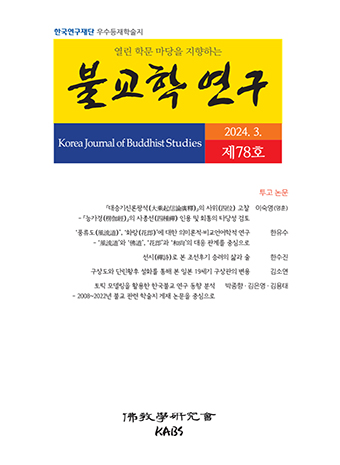Abstract
References
Sorry, not available.
Click the PDF button.
Information
This paper is a philological study on two extant Sanskrit manuscripts of Ārya-Vimuktiṣeṇa’s commentary, commonly called Abhisamayālaṅkāravṛtti. The contents of this article can be divided into two parts: a newly identified Nepalese manuscript of the Abhisamayālaṅkārakārikā, and research on the colophon of the two manuscripts preserved in Nepal and Tibet. This paper is notable for being the first study of based on the Tibetan manuscript, which was displayed to a small group of experts at Beijing University in 2014. Inside the Nepalese manuscript (NGMPP A 37/09) written in Nevārī script with hooked top, three folios are mistakenly inserted whose contents are in fact the Kārikās. In another Nepalese manuscript, NGMPP A 35/12, the first nine folios identified as a manuscript of the Abhisamayālaṅkārakārikā are also added to Haribhadra’s commentary. Among the nine folios, only five folios are written in the hooked Nevārī script. I find these eight folios in the Nevārī script originally constituted one and the same manuscript of the Abhisamayālaṅkārakārikā, which was placed before Ārya-Vimuktiṣeṇa's commentary text in the original manuscript. Second, I point out two discoveries about the colophon of the manuscripts in Nepal and Tibet, 1) The two manuscripts were both written in the early 12th century. The Nepalese manuscript is dated to the 32nd year of the king Dharmapāla (r. 1108-1113), while the part of the colophon that states the exact date of the manuscript in the Tibetan manuscript is missing. But given that the latter manuscript was a religious gift from Śubhākaragupta, a student of Abhayākaragupta who composed the Munimatālaṅkāra in the 30th year of the king Dharmapāla, it is clear that the two manuscripts were contemporary. 2) According to the colophon, Ārya-Vimuktiṣeṇa’s commentary is called Abhisamayālaṅkāraśāstra, which is the same with the title of the Kārikās traditionally ascribed to Maitreyanātha. In the recto of the first folio (1r) of the newly identified manuscript, the text consisting of the Kārikās alone is titled “a commentary on the Prajñāpāramitā by Ācārya-Vimuktisena.” These facts indicate the possibility that Ārya-Vimuktiṣeṇa himself composed the Kārikās that is believed to be a work of Maitreyanātha. Consulting other materials such as the Tibetan translation of the Abhisamayālaṅkārakārikā from the end of 11th century, I also make reference to three different opinions about the authorship of the Kārikās: Maitreyanātha, Ārya-Vimuktiṣeṇa, and an anonymous author.
본 논문은 아리야 비묵띠세나의 현관장엄론 주석서사본을 기반으로 한 문헌학적 작업의 일환이다. 이 주석서에는 현재 네팔과 티벳에서 보존된 두 종류의 산스크리트사본이 이용가능한데, 이 논문은 2014년에 북경대학에서 소수의 전공자들에게 접근을 허용한 티벳사본에 근거한 최초의 작업이라는 점에서 그 가치를 둘 수 있다. 논문의 내용은 크게 둘로 나뉜다. 첫째는 필자가 새로 확인한 현관장엄론 게송사본에 대한 보고이다. 아리야 비묵띠세나의 네팔사본(NGMPP A 37/09: 야자나무잎에 갈고리형 네와리로 쓰임)에는 현관장엄론 게송을 필사한 세 폴리오가 97․99․100번째 폴리오로 삽입되어 있다. 또한 하리바드라의 주석서 사본(NGMPP A 35/12)에는 주석서 앞에 현관장엄론 게송 아홉 폴리오가 첨가되어 있다. 후자는 원래 갈고리형 네와리로 야자나무잎에 쓴 다섯 폴리오에 결락된 부분을 보충하고자 하는 목적으로 데바나가리로 종이에 쓴 폴리오를 잇거나 첨가한 사본이다. 필자는 각각 다른 사본으로 흩어져 있던 이 두 종류의 야자나무잎 현관장엄론 게송 사본을 비교한 결과, 원래 하나의 사본이었다는 사실을 밝혔다. 또한 몇몇 전거를 들어 이 게송사본이 원래 아리야 비묵띠세나의 주석서사본과 한 묶음이었다는 점을 논증하였다. 둘째는 아리야 비묵띠세나 주석서의 네팔사본과 티벳사본의 마지막 콜로폰에 관한 연구이다. 필자는 우선 이 콜로폰을 전사(轉寫), 편집, 번역한 후 다음의 두 사실을 밝혔다. 1. 네팔사본과 티벳사본 모두 동시대라고 할 수 있는 12세기에 필사되었다. 네팔사본은 콜로폰에 다르마팔라 왕 재위 32년(1108~1113년)에 필사되었다는 정확한 정보가 기입되어 있다. 티벳사본은 필사연대에 관한 부분이 결락되었지만, 다르마팔라 왕 재위 30년에 현관장엄론의 주석서를 쓴 아바야까라굽타의 제자인 슈바까라굽타가 보시한 사본이라는 점에서 네팔사본보다는 약간 늦지만 동시대라고 할 수 있는 12세기 초에 필사되었다고 결론지었다. 2. 콜로폰과 제명(題名)이 나타나 있는 첫 번째 폴리오의 앞면을 통해서 보자면, 마이트레야나타(미륵)의 저술로 전해지는 현관장엄론 게송이 아리야 비묵띠세나의 저술일 가능성이 있다. 필자는 콜로폰 이외에도 티벳역과 새로 확인된 게송사본의 자료 등을 통해 현관장엄론 게송의 저자 귀속에 관하여 1)아리야 비묵띠세나 2)작자 미상 3)마이트레야나타의 세 가지 흐름이 있었다는 사실을 밝혔다.
Click the PDF button.
- Publisher :Korean Association of Buddhist Studies
- Publisher(Ko) :불교학연구회
- Journal Title :Korea Journal of Buddhist Studies
- Journal Title(Ko) :불교학연구
- Volume : 43
- No :0
- Pages :217 ~ 243


 Korea Journal of Buddhist Studies
Korea Journal of Buddhist Studies






